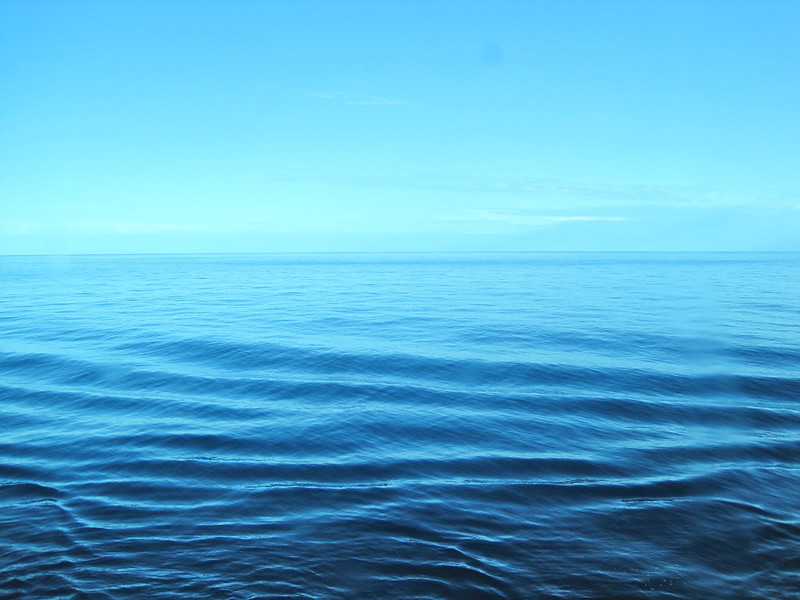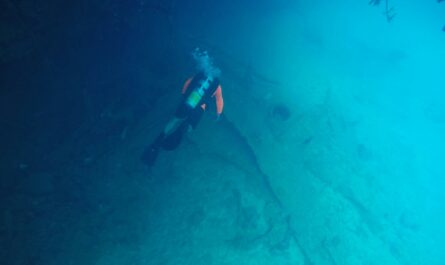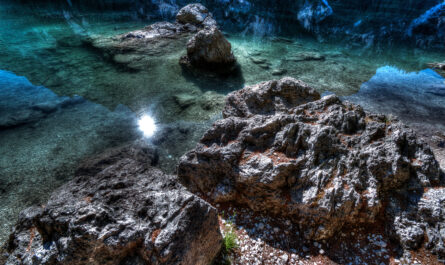The Kuroshio Current, often called the “Black Stream” due to the deep blue and almost black appearance of its waters, is one of the world’s strongest and most vital ocean currents. Like the Atlantic’s Gulf Stream, the Kuroshio is a western boundary current, meaning it flows along the western edge of the Pacific Ocean basin. Originating east of the Philippines, it travels northward along the coast of Taiwan and Japan, merging with the North Pacific Current to influence both the climate and ecosystems of the North Pacific Ocean.
As a key player in global ocean circulation, the Kuroshio Current serves as a “marine superhighway,” not only transporting heat and nutrients but also supporting fisheries, weather patterns, and biodiversity in the surrounding regions. It impacts local economies, marine ecosystems, and even broader climatic systems.
1. The Physical Characteristics of the Kuroshio Current
The Kuroshio Current is characterized by its speed, temperature, and volume. It is a powerful force, transporting 50 million cubic meters of water per second, making it the largest ocean current in the western Pacific. Its warm waters are crucial for maintaining regional temperatures and supporting life both at sea and on land.
- Speed: The Kuroshio can reach speeds of up to 2.5 meters per second, depending on its location, and typically flows at 1 to 2 meters per second. The high speed of this current is typical of western boundary currents, which are faster and narrower than other currents due to the Coriolis effect, a phenomenon caused by Earth’s rotation.
- Temperature: The waters of the Kuroshio Current are warm, typically ranging between 24°C to 28°C (75°F to 82°F). This warmth is a crucial feature, as it has a moderating effect on the climate of East Asia, particularly Japan, where it helps to keep winters milder.
- Depth and Width: The Kuroshio Current is a deep and wide current, extending down to depths of up to 1,000 meters (3,280 feet) and spanning a width of 100 kilometers. The vast size and volume of this current make it a critical driver of oceanic and atmospheric processes in the region.
2. Oceanographic and Ecological Significance
The Kuroshio Current plays a crucial role in shaping both marine ecosystems and oceanic circulation in the Pacific. As a warm, nutrient-rich current, it is essential to the biodiversity of the regions it touches, particularly in the western Pacific. It also plays a significant part in global ocean circulation patterns, which helps regulate Earth’s climate.
Marine Ecosystems
One of the most important ecological roles of the Kuroshio Current is its ability to transport nutrients from tropical regions to more temperate waters, thereby supporting rich marine biodiversity along its path. This current is a highway for:
- Migratory Species: Many species, such as tuna, mackerel, and swordfish, migrate along the Kuroshio. For these commercially valuable species, the current provides a vital pathway between their breeding and feeding grounds.
- Sea Turtles: The Kuroshio is an essential migratory route for loggerhead sea turtles, which use the current to travel from their nesting beaches in Japan to the rich feeding grounds in the North Pacific.
- Plankton and Fish Larvae: The current transports a vast amount of plankton and fish larvae, which form the base of the food web in the open ocean. This process is particularly important in supporting the fisheries of Taiwan, Japan, and the Philippines.
In addition to its role in sustaining marine life, the Kuroshio also helps regulate water temperatures and nutrient distribution, making it a key player in maintaining ocean productivity in the North Pacific.
Ocean Circulation
The Kuroshio is a critical part of the global ocean circulation system. It transports warm water northward, balancing the cold, nutrient-rich waters that flow southward from the polar regions. This system of thermohaline circulation (also called the global conveyor belt) plays an essential role in redistributing heat around the world, impacting everything from weather patterns to marine life. In the North Pacific, the Kuroshio influences:
- El Niño and La Niña Phenomena: These large-scale ocean-atmosphere phenomena, which influence global climate patterns, are affected by changes in the Kuroshio Current. During El Niño, for example, the flow of warm water in the Pacific can alter the strength and position of the Kuroshio, leading to changes in weather patterns across East Asia and North America.
- Typhoon Formation: The warm waters of the Kuroshio provide energy for typhoons (the Pacific equivalent of hurricanes), making the region more susceptible to extreme weather events. As the current flows northward, its warm waters mix with colder air, creating ideal conditions for the formation of powerful storms.
3. The Kuroshio Current’s Influence on Climate and Weather
The Kuroshio Current has a profound effect on the climate of the Asia-Pacific region, particularly on the eastern coastlines of Taiwan and Japan. It serves as a heat transport mechanism, carrying warm water from the tropics to the temperate regions, helping to moderate the coastal climate of these areas.
Temperature and Precipitation Patterns
One of the most significant climatic impacts of the Kuroshio Current is its effect on winter temperatures in Japan. The warm waters of the current keep coastal areas, especially those facing the Pacific, much warmer in the winter than they would otherwise be. In contrast, regions further inland or on the Sea of Japan coast experience much colder winters. The current’s warmth contributes to:
- Milder Winters in Japan: The cities along Japan’s Pacific coast, such as Tokyo and Osaka, benefit from the warmth of the Kuroshio, which helps to keep winter temperatures higher than in other regions of similar latitude. This moderating effect is one of the reasons why Tokyo has a much milder winter than cities at similar latitudes, such as Beijing or New York.
- Increased Rainfall: The current also influences rainfall patterns. As warm air masses from the Kuroshio encounter cooler air over land, they can trigger precipitation. This process contributes to Japan’s rainy season in early summer, known as tsuyu, as well as the monsoon season in Taiwan and the Philippines.
Extreme Weather Events
The Kuroshio is also responsible for intensifying typhoons in the western Pacific. As warm surface waters fuel these storms, the Kuroshio’s high temperatures make it an ideal breeding ground for powerful typhoons, which can cause widespread damage across East Asia. Typhoons like Typhoon Vera (1959) and Typhoon Haiyan (2013) are examples of devastating storms that formed over the warm waters of the Kuroshio.
With climate change, the frequency and intensity of these storms are likely to increase, posing greater risks to the coastal regions that rely on the current’s beneficial effects.

4. The Kuroshio and Human Impact: Fisheries, Shipping, and Renewable Energy
The Kuroshio is not only a natural phenomenon but also a vital resource for human activities. From supporting fishing industries to providing a pathway for shipping and even generating renewable energy, the current has far-reaching effects on the economies of East Asia and beyond.
Fisheries and Food Security
The fisheries along the Kuroshio are among the most productive in the world. Japan’s fishing industry, in particular, relies heavily on species that thrive in the current’s nutrient-rich waters, such as bluefin tuna, mackerel, and yellowtail. The warm waters of the Kuroshio attract these species, which migrate along its path to feed on plankton and smaller fish.
- Economic Importance: The fisheries supported by the Kuroshio are a critical part of the economies of Japan, Taiwan, and the Philippines. The fishing industry in these countries provides employment for millions of people and contributes significantly to food security in the region.
- Conservation Challenges: Overfishing, however, remains a major concern. Species like bluefin tuna have been overexploited, leading to drastic population declines. As a result, regional governments and international organizations are working to implement sustainable fishing practices and protect the delicate balance of the marine ecosystem.
Shipping and Navigation
The Kuroshio also serves as a critical route for oceanic navigation. For centuries, traders and sailors have used the current’s swift flow to travel between Southeast Asia, Japan, and the Pacific islands. Today, the Kuroshio continues to be a major shipping route, helping vessels travel faster across the Pacific by using the current’s powerful flow to their advantage.
- Strategic Importance: The Kuroshio’s location makes it a strategically important region(Continuing with the extension…)
The Kuroshio’s location makes it a strategically important region for international shipping. Japan, Taiwan, and other nations in the Asia-Pacific region depend on the current for faster shipping routes that save fuel and time. For centuries, traders and sailors have used the Kuroshio as a natural conveyor belt for faster navigation, and today, the current plays an integral role in global maritime trade. This reliance on the Kuroshio has implications for geopolitical stability, as controlling these routes is vital for both commerce and military operations.
Renewable Energy Potential
One of the most promising aspects of the Kuroshio Current is its potential to generate renewable energy. Scientists and engineers are exploring ways to harness the energy of the current through ocean current power technologies. These systems work similarly to underwater wind turbines, capturing the kinetic energy of the flowing water and converting it into electricity.
- Experimental Projects: In recent years, several experimental projects have been launched to tap into the Kuroshio’s energy potential. In Japan, the Okinawa Institute of Science and Technology has tested ocean current turbines designed to harness the consistent flow of the Kuroshio. The hope is that these turbines could eventually generate a substantial amount of clean energy, helping to reduce Japan’s dependence on fossil fuels.
- Sustainability and Challenges: The key challenge to harnessing the energy of the Kuroshio lies in the technical complexity of installing and maintaining turbines in deep, fast-moving water. Additionally, there are environmental concerns about the potential impact of such installations on marine ecosystems and migratory species. However, if these hurdles can be overcome, the Kuroshio could become a significant source of renewable energy in the future.
5. Scientific Research and Monitoring of the Kuroshio
The Kuroshio has long been a subject of interest for oceanographers, climate scientists, and marine biologists. Understanding the Kuroshio is essential not only for managing fisheries and predicting weather patterns but also for studying the broader global ocean circulation and its role in regulating climate. Over the years, technological advancements have made it easier to study and monitor the current in detail.
Observational Technologies
Several advanced technologies are used to study the Kuroshio, including:
- Satellite Imaging: Satellites equipped with sensors can track the movement, temperature, and flow speed of the Kuroshio from space. These tools provide real-time data that help scientists monitor changes in the current over time.
- Ocean Drifters and Buoys: Drifters are floating devices that move with the ocean currents and collect data on water temperature, salinity, and flow patterns. By releasing large numbers of drifters into the Kuroshio, scientists can study the current’s path and the forces that influence it.
- Submersibles and Autonomous Underwater Vehicles (AUVs): AUVs are used to explore the deeper parts of the Kuroshio, collecting data on marine life, water chemistry, and ocean floor topography. These underwater robots can operate at depths that would be inaccessible to humans, allowing for a deeper understanding of the current’s effects on marine ecosystems.
Key Research Areas
Some of the most important areas of research related to the Kuroshio Current include:
- Climate Change Impact: Researchers are studying how climate change is affecting the Kuroshio Current and its surrounding ecosystems. As global temperatures rise, the current’s flow patterns and temperature may change, which could have significant impacts on the region’s climate, fisheries, and biodiversity.
- Marine Biodiversity Studies: The Kuroshio Current supports a diverse range of marine life, and scientists are continually discovering new species in its waters. By studying the biodiversity of the Kuroshio, researchers can learn more about the health of marine ecosystems and the effects of human activities such as overfishing and pollution.
- Ocean Circulation Models: Understanding the Kuroshio is also essential for improving ocean circulation models, which are used to predict everything from sea level rise to weather patterns. These models are crucial for developing strategies to mitigate the effects of climate change on coastal communities.
6. The Future of the Kuroshio Current in a Changing World
The Kuroshio Current, like all ocean currents, is not immune to the effects of climate change and human activity. Understanding how the current will evolve in the coming decades is essential for managing the environmental and economic impacts of these changes.
Climate Change and Ocean Currents
One of the biggest uncertainties facing scientists today is how climate change will affect ocean currents like the Kuroshio. As global temperatures rise, changes in wind patterns, ocean temperatures, and salinity could alter the flow of the current. Some models suggest that the Kuroshio could become stronger in the coming decades due to increasing sea surface temperatures, while others predict a weakening of the current as the polar ice caps melt and add fresh water to the ocean.
- Impact on Fisheries: Any significant changes to the Kuroshio Current would have profound implications for fisheries in the region. A stronger or weaker current could alter the migration patterns of fish, leading to changes in fish populations and the availability of certain species. This would, in turn, impact the economies of countries that rely heavily on fishing.
- Impact on Climate: Changes in the Kuroshio’s strength or position could also affect the climate of East Asia, particularly Japan. A weakening current could lead to cooler winters and reduced rainfall, while a stronger current could exacerbate the intensity of typhoons and lead to more extreme weather events.
Conservation Efforts and Sustainable Practices
As human activities continue to affect the marine environment, there is an urgent need for conservation efforts to protect the ecosystems supported by the Kuroshio Current. Governments, NGOs, and scientists are working together to promote sustainable fishing practices, reduce pollution, and protect endangered species that depend on the current.
- Marine Protected Areas (MPAs): One of the most effective ways to conserve marine biodiversity is by establishing Marine Protected Areas. Several MPAs have already been created along the path of the Kuroshio, particularly in Japan and Taiwan. These areas help protect critical habitats for fish, sea turtles, and other marine life.
- Public Awareness and Education: Raising public awareness about the importance of the Kuroshio Current and the challenges it faces is also crucial for long-term conservation. Educational campaigns, particularly in coastal communities, can help promote sustainable fishing practices and reduce pollution.
Conclusion: A Vital Ocean Highway
The Kuroshio Current is not only a vital component of the Pacific Ocean’s circulation system but also a lifeline for the millions of people and countless marine species that depend on it. From moderating the climate of East Asia to supporting some of the world’s most productive fisheries, the Kuroshio is a powerful force that shapes the natural and human worlds. As the impacts of climate change and human activities become more pronounced, it is crucial to continue studying and protecting this remarkable current.
With further research, technological innovations, and sustainable practices, we can ensure that the Kuroshio Current continues to thrive, providing benefits to both the environment and human society for generations to come.



